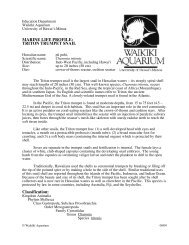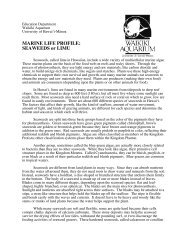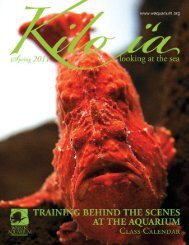Create successful ePaper yourself
Turn your PDF publications into a flip-book with our unique Google optimized e-Paper software.
monk seal<br />
Photo courtesy of NOAA.<br />
Rescue<br />
The Waikïkï <strong>Aquarium</strong> stepped in to lend a hand during a recent rescue<br />
mission to help a Kauaçi monk seal. The young seal, code named DP4,<br />
had been observed with fishing gear dangling <strong>from</strong> her mouth, and<br />
NOAA Fisheries researchers were concerned that <strong>the</strong> hook had become<br />
lodged in her body — where it could have fatal results.<br />
With monk seal numbers stuttering at just 1,200, researchers stepped<br />
into action to protect her life. They airlifted <strong>the</strong> monk seal to O‘ahu by a<br />
Coast Guard C-130 patrol plane on June 24. She was <strong>the</strong>n transported by<br />
truck to <strong>the</strong> <strong>Aquarium</strong>, where she was placed in a 20-foot holding tank<br />
behind <strong>the</strong> scenes.<br />
While <strong>the</strong> <strong>Aquarium</strong> was able to provide <strong>the</strong> space to house <strong>the</strong> monk<br />
seal, staff set up strict quarantine boundaries during <strong>the</strong> mission, says<br />
<strong>Aquarium</strong> Biologist Leah Kissel.<br />
“We didn’t want to risk <strong>the</strong> transmission of disease between <strong>the</strong> wild<br />
animal or our two monk seals,” she says. “Their staff entered through a<br />
separate side gate; we didn’t even shake hands.”<br />
Later that week, DP4 was taken to a veterinary hospital, where a team<br />
of veterinarians flown in <strong>from</strong> <strong>the</strong> Mainland conducted an x-ray, ultrasound<br />
and endoscopic procedure. Happily, DP4 avoided surgery; <strong>the</strong>y<br />
found no traces of <strong>the</strong> hook, leading to <strong>the</strong> assumption that it somehow<br />
had worked free on its own.<br />
After a short period back at <strong>the</strong> <strong>Aquarium</strong>, <strong>the</strong> monk seal was flown<br />
back to Kauaçi and released on <strong>the</strong> beach where she had been picked up.<br />
She promptly headed back out to sea.<br />
Photo: Kelsey Ige.<br />
The S.S. Junk Raft<br />
A pile of junk landed on <strong>the</strong> <strong>Aquarium</strong>’s front lawn in August — and we<br />
couldn’t have been happier. It was <strong>the</strong> junk raft, a 30-foot concoction of<br />
15,000 plastic bottles that two eco-mariners sailed <strong>from</strong> California to Hawaiçi<br />
in an effort to call attention to all <strong>the</strong> plastic trash floating in our seas.<br />
North of Hawaiçi, in <strong>the</strong> North Pacific Gyre, <strong>the</strong>re is now more<br />
plastic, by weight, than plankton. The floating trash interrupts <strong>the</strong> feeding<br />
of marine life — it can choke birds and <strong>the</strong> plankton ingest it — and <strong>the</strong><br />
plastics release toxins into <strong>the</strong> water.<br />
It took Dr. Marcus Eriksen and Joel Paschal nearly three months to<br />
make <strong>the</strong>ir crossing. They ate peanut butter along with <strong>the</strong> mahimahi and<br />
squid <strong>the</strong>y caught along <strong>the</strong> way. Disturbing Thought No. 1: The toxins in<br />
<strong>the</strong> plastics that <strong>the</strong>se fish eat are now entering our own bodies. Disturbing<br />
Thought No. 2: They also caught plenty of plastic in <strong>the</strong>ir drag net<br />
— hundreds of particles at a time.<br />
You can read more about efforts to tackle <strong>the</strong> problem by voyage<br />
sponsors Algalita Marine Research Foundation (www.algalita.org) or go<br />
to <strong>the</strong> junk blog at www.junkraft.com.<br />
FISH<br />
Circle November 9 on your<br />
calendar and come and join<br />
us for Members’ Night. The<br />
FOWA annual meeting will<br />
be followed by good food and<br />
a presentation by none o<strong>the</strong>r<br />
than <strong>Aquarium</strong> <strong>Director</strong> Dr.<br />
Andrew Rossiter, who will take<br />
you on a safari of some of <strong>the</strong><br />
most fascinating fish facts in<br />
<strong>the</strong> world. See page 7 for more<br />
information.<br />
Safari<br />
3








